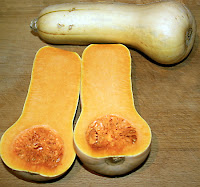There's a chill in the air and the leaves have begun the journey from the branches to the ground as the days grow shorter. A sense of melancholy begins to wash over the sun worshipers of summer as we prepare for the cold dark winter. The arrival of the season's first frost brings two things to mind and they're not doom and gloom, they're Soup and Squash!
Back in 1966 a Scottish singer\songwriter named Donavon called it the
Season of the Witch and like Donavon when I look out my window there are many sights to see. Big bright orange pumpkins, wavy dark green acorn, pale yellow spaghetti and the beige stretched bell of the Butternut. Squashes all!
Few things in the produce aisle evoke more confusion, fear and outright avoidance then the winter squashes. The squashes of summer are fun, familiar and friendly. Zucchini's baked in breads and quiches. Sauteed, grilled, roasted, battered and fried we love them.
 |
| Butternut Squash |
Winter squash on the other hand is unfamiliar ground with the exception of the pumpkin which is either the subject of ritual mutilation or baked into pies. Almost without exception starting in early fall I hear the same question on my forays to the supermarket, "Excuse me, but what are those and what do you do with them?" To which I reply with a decided sense of squash swagger "They're butternut squash and I eat them!"
You might think that pointing out that I eat a given produce would end with the recipient of my snooty response turning on his or her respective heal and mumbling to themselves about what a jerk I am but you would be wrong. A look of surprise crosses their faces as they each utter the same one word, REALLY! Not the back at you wiseguy kind of really, but a genuinely surprised really.
The butternut squash is similar to the pumpkin in texture and flavor which is slightly sweet and mildly nutty and can and often is substituted for pumpkin in pie making mostly because they are easier to handle, size wise. Like pumpkins you don't eat the skin but you can roast and eat the seeds if you like.
Bisque is a rich, creamy well seasoned style of soup that has its' roots in french cuisine and sounds more imposing then it is to make. So rest assured there is no reason to run screaming from the room if both butternut squash and bisque are Greek or in this case French to you.
Ingredients:
2 Average Size Butternut Squash
2 Quarts of Chicken Stock
2 Sprigs of Fresh Thyme
2 Sprigs of Fresh Rosemary
1 Bay Leaf
1 Tsp Salt
1/2 Tsp Cayenne Pepper
Optional Ingredients:
Heavy Cream or Roux
Preparation:
Begin by cutting the stem and bottom off your squash and then peel them with an regular vegetable peeler as the skin is not very thick or tough. Once the are peeled cut them in two lengthwise and remove the seeds. Remember the seeds can be roasted and eaten just like pumpkin seeds. Cut the halves into 3/4" pieces and place them on a cookie sheet to bake in a 375 degree oven until then are fork tender.

Some of you are thinking, do I have to roast them in the oven? The answer is if you want Roasted Butternut Squash Bisque you do! However if you just want ordinary Butternut squash bisque you can follow the instructions above and just boil them until tender. BUT and that's a BIG BUT, you will not have that smokey quality that comes with roasting.
While the squash is roasting add the 2 quarts of chicken stock to a five quart pot and on medium\high heat add the bay leaf, salt, rosemary and thyme. I like to use a piece of kitchen string to tie by rosemary and thyme together in what is called a Bouquet Garni which is a sophisticated bundle of herbs with a french accent and sounds very impressive. Mostly it makes it easy to remove later.
Place the tender squash in a blender or food processor along with some chicken stock. The amount of stock depends on what your blender or food processor is going to need to allow you to puree the squash. Before adding the puree to the pot with the remaining stock remove the bouquet garni and the bay leaf as they have done their work and are no longer needed.
Cook on low heat for 15-20 to allow the bisque to thicken. Stir in the cayenne pepper 1/8 tsp at a time and sample the bisque and continue to add remaining until it is either all in or spicy enough for your taste.
Optionally at this point you can add either the heavy cream or roux to the bisque to thicken. Continue to on heat for an additional five minutes and serve, refrigerate or freeze.
 Leeks tend to pick-up bits of grit and sand as they sprout from the soil
and need to be cleaned thoroughly. Start by trimming away the inedible
tops and the root bottom. Splint the leeks length wise and then
slice the halves about 1/4 inch wide. Place the cut leeks in a colander
an rinse thoroughly with cold water and drain.
Leeks tend to pick-up bits of grit and sand as they sprout from the soil
and need to be cleaned thoroughly. Start by trimming away the inedible
tops and the root bottom. Splint the leeks length wise and then
slice the halves about 1/4 inch wide. Place the cut leeks in a colander
an rinse thoroughly with cold water and drain.
